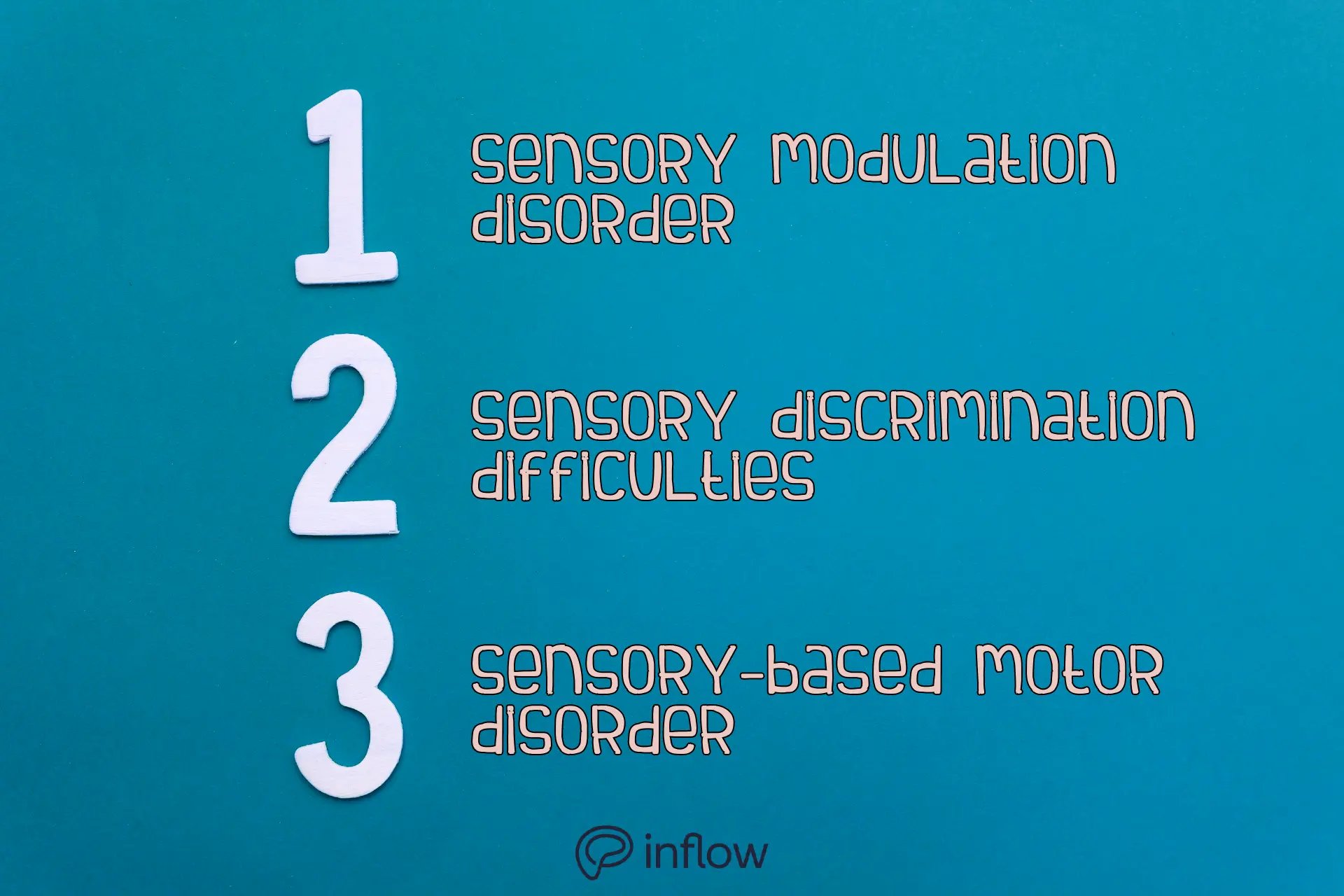You know how when you’re walking in the dark, your eyes adjust to the light, allowing you to see where you’re going? Or when you’re engrossed in a good book, and you can’t hear your name being called by your roommate?
A ‘typical’ brain has filters that are adjusted based on the environment. On the other hand, a brain with sensory processing issues has filters that function differently, and they may allow too much — or too little — information through. Let’s explore the causes, symptoms, and treatments of sensory processing disorder (SPD).
What is a sensory processing disorder?
Typically, sensory processing allows us to separate the relevant stimuli from irrelevant stimuli.
When someone’s sensory processing is disordered, however, they may be unable to filter incoming information because their brain has difficulties processing and responding to sensory input, or ‘data’.1
While it’s not an official medical diagnosis according to the Diagnostic and Statistical Manual of Mental Disorders (DSM-V), sensory processing disorder can cause people to become overwhelmed by common, everyday stimuli.
What is ADHD?
Attention-deficit/hyperactivity disorder, or ADHD, is a neurodevelopmental condition that can cause symptoms such as the following:
- Inattention
- Hyperactivity
- Impulsive behavior
- Difficulty focusing
- Impatience
Other neurodiverse conditions
Like sensory processing disorder, ADHD can lead to difficulties with choosing the ‘right thing’ to focus on. And while anyone can have issues with sensory processing, it’s more common in the neurodiverse community — people with conditions like:
- Autism
- Obsessive-compulsive disorder
- Anxiety
- Dyslexia
- Borderline personality disorder
- Bipolar disorder
Sensory disorders vs. ADHD
What causes ADHD?
While they have similar symptoms, ADHD and SPD are believed to have unique causes. ADHD is most likely caused by insufficient neurotransmitters –like dopamine and norepinephrine– and/or their respective transporters.2
ADHD may also be caused by structural abnormalities in the front of the brain (prefrontal cortex or PFC) where the executive function network lives.3
What causes sensory processing disorder?
Researchers believe that SPD may be caused by abnormal white matter in the brain that doesn’t transport information properly.4
The two conditions are often confused, which only causes more issues due to improper or insufficient treatment.
ADHD and sensory overload
People with ADHD often struggle with impulsiveness, inattentiveness, lack of environmental awareness, and hyperfocus. Any of these symptoms could increase the likelihood of sensory overload.
Prescription medications for ADHD allow you to focus, but can also make you focus too much on the sensory input that’s bothering you. Someone with ADHD and SPD might feel like a quiet ticking sound is louder than someone speaking in front of them because their brain is focused on the ‘wrong thing’.
Hypersensitivity in women with ADHD
Females are more likely to have SPD than males.5 Since SPD differently engages brain regions responsible for reward processing memory, empathy, and awareness6, women with SPD may find that they experience higher emotional sensitivity. This causes higher sensitivity to criticism or a quick temper.
Burnout from external stimuli
Having both ADHD and SPD can be exhausting.
Someone with ADHD and SPD might act impulsively and then become extremely anxious after realizing they broke a social norm.
For example: SPD may cause you to hear more conversations, and ADHD could cause you to hyperfixate on those conversations more than another observer. This means that overhearing strangers arguing could bother you for weeks instead of a typical five minutes.
What are 3 types of sensory disorders?

Sensory disorders aren’t always caused by flashing lights or loud music. There are 3 types of sensory disorders that are caused by different forms of stimuli.
Sensory modulation disorder
In a sensory modulation disorder, the person has difficulty responding to sensory stimuli.7 They might respond too much to stimuli, too little, or possibly crave a certain type of stimulation.
Sensory discrimination difficulties
Sensory discrimination is an umbrella term for postural disorder and dyspraxia.
A postural disorder causes an inability to perceive your body positioning and poor core stability. Dyspraxia is a complication in completing balanced and skilled movements.
Sensory-based motor disorder
A sensory-based motor disorder makes it difficult for the person to decipher different words and sometimes someone talking might sound like their words are slurring together or hard to understand.
Visually, a sensory-based motor disorder can make it hard to read because letters appear in the wrong place. Scientists are beginning to explore this connection with dyslexia.8
Sensory overload: signs and symptoms
Symptoms of sensory overload can include:
- Inability to focus
- Anxiety
- Anger
- Irritability
- Actively avoiding triggering spaces
- Fidgeting
- Burnout and fatigue
- Social stress or social anxiety
Overstimulation in the 8 senses
A sensory processing disorder can affect just one or all of the eight senses:
- Touch, or tactile
- Taste, or gustatory
- Hearing, or auditory
- Sight, or visual
- Smell, or olfaction
- Proprioception, or spatial awareness
- Vestibular processing, or balance
- Interoception, or self-awareness
1. Overstimulated by touch: feeling ‘touched out’
Too light or firm of touch can be intolerable for some. A spontaneous hug can be overwhelming; certain textures of clothing, or an irritating tag can be overstimulating; the feeling of water when swimming, or the textures of certain foods or objects.
2. Taste overload: being a ‘picky eater’
Spicy foods, intense flavors, food temperatures, and food textures can trigger a response.
3. Overstimulated by sound: ‘hearing the lights’
Hypersensitivity to multiple conversations at once, loud music, grating noises, and the sounds of technology are overstimulating to many people with hypersensitivity to sounds.
4. Overloaded by smell: being the first to smell everything
For someone with a heightened sense of smell, strong odors like perfumes, shampoo, food, and detergent can be overwhelming. Additionally - and unfortunately - it can also lead to physical responses, like headaches and nausea.
5. Overstimulated by visuals: “my eyes!”
Harsh flashing lights, too many colors, or just too much to look at can be a painful experience for those of us with highly sensitive visual receptors. It can lead to watering eyes or even migraines.
6. Proprioceptive overstimulation: being ‘uncoordinated’
This is the system that lets you know where your body parts are and detects force and pressure. People who have a delay in the development of their proprioceptive system may consistently bump into objects, have poor hand-eye coordination, and experience frequent injuries.
7. Vestibular overload: feeling dizzy or unbalanced
The vestibular system detects changes in gravity and tells you if you’re sitting, standing, or lying down. People who have sensitivity issues to the vestibular system may appear clumsy, get motion sickness, or prefer stationary activities.
8. Interoceptive overload: despising itchy tags and clothes
This sense lets your body know how you’re feeling. Knowing that you’re hungry or need to use the bathroom comes from this sense. An itch may feel painful or a hunger pang may come on unexpectedly.
Treating and managing sensory overload in ADHD
While there is no cure for sensory processing disorder, there are methods you can use to treat it.
1. Stay educated
Learn more about your sensory processing issues to prepare for the next time you encounter them. Knowing your triggers makes it easier to shop for clothing that won’t irritate you or foods you’ll actually eat.
2. Find coping mechanisms that work for you
Try putting on headphones and playing brown noise if a room is too loud, or go into a private space and turn off the lights if you’ve been visually overstimulated.
3. Establish a routine — and stick to it!
Establishing a routine means you reduce the risk of overstimulating surprises. Routinely shopping early before the crowds and going to the same quiet restaurants means you know what to expect when you arrive. Adding exercise into your routine can also help reduce pent-up energy and stress.
How to prevent overstimulation
Preventing sensory overstimulation might be easier than you think.
- Pack safe foods you know you like
- Try wearing a shirt under your blouse so the fabric doesn’t irritate your skin
- Read the menu before arriving at a restaurant if you struggle reading in loud environments
- Explore the principles of structured exposure therapy with a sensory integration therapist
Frequently asked questions

Can ADHD cause sensory issues?
While ADHD itself doesn’t cause problems with processing sensory input, sensory processing disorders are a common co-occurring experience among many ADHDers.
What does overstimulation look like in someone with ADHD?
When someone with ADHD is overstimulated by their surroundings, they may experience:
- Difficulty focusing (even more than before)
- Angry outbursts
- Fatigue
- Emotional burnout
Does everyone with ADHD have SPD?
No, but it is common in the ADHD population.
How many senses are there that can be affected by sensory overload?
As far as we know, there are eight—the five everyone knows about (sight, smell, sound, touch, taste), then the remaining three:
- Vestibular processing, which aids in balance
- Proprioception, which aids in physical self-awareness
- Interoception, which is involved with picking up internal cues from our bodies
How can you get rid of ADHD overstimulation?
Try to identify and understand your specific triggers so you can better prepare for them in advance. Some people may opt for exposure therapy, while others choose to put ‘guardrails’ in place when they have an upcoming, triggering event.
There are also resources, such as the Inflow app, which has a learning module on sensory processing disorders and how they relate to ADHD.
Depending on the sort of stimuli you struggle with, you may consider investing in ear plugs, sunglasses, or tag-less clothes – just as examples.




.jpg)


